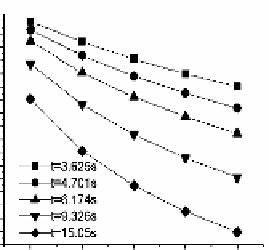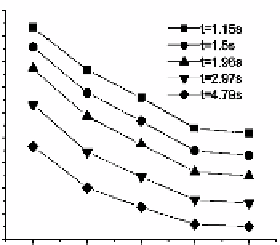Environmental Engineering Reference
In-Depth Information
4.3.3.2 Prediction of Mercury Oxidation using Established Model
The established model could be used to predict the degree of transformation from
Hg
0
to Hg
2+
in coal-fired flue gas. The prediction results are affected by the fol-
lowing factors: HCl concentration, residence time, reaction temperature, other gas
components, and so on. The model mainly considered the reaction between mercury
and HCl which could be applied to predict the impact of HCl concentration, resi-
dence time, reaction temperature, Hg/Cl, etc. on the oxidation of Hg
0
to Hg
2+
. The
results are shown in Figs. 4.53 to 4.62.
Figs. 4.53 and 4.54 show the impact of HCl on the transformation of mercury
speciation under different conditions, which considered the parameters including
Hg
0
inlet concentration (6.478 μg/m
3
), reaction temperatures (100 and 900 °C),
residence time (3.63
100
ppm). With increasing HCl concentration during the same residence time, the Hg
0
concentration reduced. It was because increasing HCl was equivalent to increasing
Cl as the mercury oxidant. In addition, with a low HCl concentration, the impact of
mercury transformation from increased HCl concentration was relatively signifi-
cant. When HCl concentration increased from 20 to 40 ppm, the maximum distance
between the two curves was observed, indicating that the Hg
0
concentration
dropped sharply. Niksa
[7]
predicted the impact of chlorine on mercury transforma-
tion.
15.05 and 1.15
4.79 s), and HCl concentrations (20
6.0
5.0
4.5
4.0
3.5
3.0
2.5
2.0
1.5
1.0
0.5
t
=1.15 s
t
=1.5 s
t
=1.96 s
t
=2.97 s
t
=4.79 s
5.0
4.0
t
=3.625 s
t
=4.701 s
t
=6.174 s
t
=9.326 s
t
=15.05 s
3.0
20 40 60 80 100
C
HCl
(ppm)
20 40 60 80 100
C
HCl
(ppm)
Fig. 4.54
Impact of HCl on Hg
0
oxidization at
900 °C, residence time from 1.15 to 4.79 s
Fig. 4.53
Impact of HCl on Hg
0
oxidization at
100 °C, residence time from 3.6315.05 s
Fig. 4.55 and Fig. 4.56 show the impact of temperature on the transformation of
mercury speciation with the reaction condition of 6.478 μg/m
3
Hg
0
inlet concen-
tration, 20 or 40 ppm HCl concentrations, and 1.15
15.05 s res-
idence time, respectively. As results show, the reaction temperature increased while
the Hg
0
concentration dropped, indicating that a higher temperature in a certain
temperature range promoted the oxidation of Hg
0
. In addition, at lower HCl con-
centration, when the residence time was shorter, the transformation of mercury
speciation was less affected by temperature; when the residence time was longer,
the impact became more significant. Using CHEMKIN, it was found that when the
4.79 s or 3.63










Search WWH ::

Custom Search